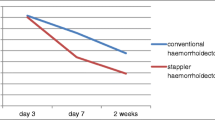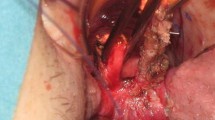Abstract
Background
Postoperative pain is a concern for patients seeking hemorrhoid surgery. Stapled hemorrhoidopexy is popular due to better patient-reported outcomes (PROs). Pain is the index of PROs. Posthemorrhoidectomy patients usually opt for a spice-free diet due to fear of pain or anal pruritus induced by spices. Curcumin and peprin (spice constituents) have powerful antiinflammatory and antioxidant properties. Ability to resume a normal taste-habituated meal may improve PRO quality of life. Thus, spice-related paradoxic conservatism in stapled hemorrhoidopexy, which involves no open wound, needed to be studied.
Methods
A prospective open-ended study (July 2008 to August 2009) investigated consecutive candidates for day-care stapled hemorrhoidopexy randomized by the date of birth method into a controlled group (receiving a spices-free diet) and a study group (receiving a spicy diet) after an ethics and informed consent protocol. A standard perioperative protocol was followed. At discharge, the patients were advised to resume a normal diet (spicy or bland) and instructed to maintain a pain diary (100-point visual analog scale [VAS]) and an analgesic diary. Paracetamol 650 mg was used for pain exceeding a VAS score of 25. Patients were followed on day 3 and weeks 1 and 3. Failure to be discharged from day care, failure to maintain patient diary, and squamous epithelium in the rectal donut were the withdrawal criteria.
Results
A total of 67 patients were randomized. The groups were well matched for demographics, comorbidities, types of anesthesia, hemorrhoidal grades, and withdrawal. Statistically significant improvement in PROs (P < 0.05) and a lower consumption of analgesic tablets were seen in the study group (spicy diet). No adverse event was reported in either group.
Conclusion
Resumption of a spicy diet has no adverse impact on PROs after stapled hemorrhoidopexy. Reduced analgesic usage in the spicy diet study group needs to be evaluated further for any potential benefits of spices.
Similar content being viewed by others
References
Sutherland LM, Burchard AK, Matsuda K, Sweeney JL, Bokey EL, Childs PA, Roberts AK, Waxman BP, Maddern GJ (2002) A systematic review of stapled hemorrhoidectomy. Arch Surg 137:1395–1406
Basdanis G, Papadopoulos VN, Michalopoulos A, Apostolidis S, Harlaftis N (2005) Randomized clinical trial of stapled hemorrhoidectomy vs. open with Ligasure for prolapsed piles. Surg Endosc 19:235–239
Gupta PJ (2007) Effect of red chili consumption on postoperative symptoms during the posthemorrhoidectomy period: randomized, double-blind, controlled study. World J Surg 31:1822–1826
Gupta PJ (2007) Effects of warm water sitz bath on symptoms in postanal sphincterotomy in chronic anal fissure: a randomized and controlled study. World J Surg 31:1480–1484
Singer MA, Cintron JR, Fleshman JW, Chaudhry V, Birnbaum EH, Read TE, Spitz JS, Abcarian H (2002) Early experience with stapled hemorrhoidectomy in the United States. Dis Colon Rectum 45:360–369
Ganio E, Altomare DF, Gabrielli F, Milito G, Canuti S (2001) Prospective randomized multicentre trial comparing stapled with open haemorrhoidectomy. Br J Surg 88:669–674
Senagore AJ, Abcarian H, Chiu YSY, Ellis CN (April 2006) Current treatment options for patients with grade III and IV hemorrhoids. Contemp Surg S1–S11. http://www.contemporarysurgery.com/uploadedFiles/Suppl_HemSurgery.pdf
Choen SF (2001) Stapled haemorrhoidectomy: pain or gain. Br J Surg 88:1–3
Tjandra JJ, Chan MK (2007) Systematic review on the procedure for prolapse and hemorrhoids (stapled hemorrhoidopexy). Dis Colon Rectum 50:878–892
Pescatori M, Fvaetta U, Dedola S, Orsini S (1997) Transanal stapled excision of rectal mucosal prolapse. Tech Coloproctol 1:96–98
Jayaraman S, Colquhoun PH, Malthaner RA (2007) Stapled hemorrhoidopexy is associated with a higher long-term recurrence rate of internal hemorrhoids compared with conventional excisional hemorrhoid surgery. Dis Colon Rectum 50:1297–1305
Burch J, Epstein D, Baba-Akbari A, Weatherly H, Fox D, Golder S, Jayne D, Drummond M, Woolacott N (2008) Stapled haemorrhoidectomy (haemorrhoidopexy) for the treatment of haemorrhoids: a systematic review and economic evaluation. Health Technol Assess 12:iii–iv, ix–x, 1–193
Altomare DF, Rinaldi M, La Torre F, Scardigno D, Roveran A, Canuti S, Morea G, Spazzafumo L (2006) Red hot chilli pepper and hemorrhoids: the explosion of a myth: results of a prospective, randomized, placebo-controlled, crossover trial. Dis Colon Rectum 49:1018–1023
Schmulson MJ, Valdovinos MA, Milke P (2003) Chili pepper and rectal hyperalgesia in irritable bowel syndrome. Am J Gastroenterol 98:1214–1215
Raahave D, Jepsen LV, Pedersen IK (2008) Primary and repeated stapled hemorrhoidopexy for prolapsing hemorrhoids: follow-up to five years. Dis Colon Rectum 51:334–341
Gautam SC, Gao X, Dulchavsky S (2007) Immunomodulation by curcumin. Adv Exp Med Biol 595:321–341
Aggarwal BB, Sundaram C, Malani N, Ichikawa H (2007) Curcumin: the Indian solid gold. Adv Exp Med Biol 595:1–75
Jagetia GC, Aggarwal BB (2007) “Spicing up” of the immune system by curcumin. J Clin Immunol 27:19–35
Krishnaswamy K (2008) Traditional Indian spices and their health significance. Asia Pac J Clin Nutr 17(Suppl 1):265–268
Aggarwal BB, Harikumar KB (2009) Potential therapeutic effects of curcumin, the anti-inflammatory agent, against neurodegenerative, cardiovascular, pulmonary, metabolic, autoimmune and neoplastic diseases. Int J Biochem Cell Biol 41:40–59
Aggarwal BB, Van Kuiken ME, Iyer LH, Harikumar KB, Sung B (2009) Molecular targets of nutraceuticals derived from dietary spices: potential role in suppression of inflammation and tumorigenesis. Exp Biol Med (Maywood) 234:825–849
Elwakeel HA, Moneim HA, Farid M, Gohar AA (2007) Clove oil cream: a new effective treatment for chronic anal fissure. Colorectal Dis 9:549–552
Thaha MA, Irvine LA, Steele RJ, Campbell KL (2005) Postdefaecation pain syndrome after circular stapled anopexy is abolished by oral nifedipine. Br J Surg 92:208–210
Corman ML, Gravié JF, Hager T, Loudon MA, Mascagni D, Nyström PO, Seow-Choen F, Abcarian H, Marcello P, Weiss E, Longo A (2003) Stapled haemorrhoidopexy: a consensus position paper by an international working party: indications, contra-indications and technique. Colorectal Dis 5:304–310
Cataldo P, Ellis CN, Gregorcyk S, Hyman N, Buie WD, Church J, Cohen J, Fleshner P, Kilkenny J 3rd, Ko C, Levien D, Nelson R, Newstead G, Orsay C, Perry WB, Rakinic J, Shellito P, Strong S, Ternent C, Tjandra J, Whiteford M, Standards Practice Task Force, The American Society of Colon and Rectal Surgeons, USA (2005) Practice parameters for the management of hemorrhoids (revised). Dis Colon Rectum 48:189–194
Lilford R, Braunholtz D, Harris J, Gill T (2004) Trials in surgery. Br J Surg 91:6–16
Kehlet H (2006) Future perspectives and research initiatives in fast-track surgery. Langenbecks Arch Surg 391:495–498
Madhok R, Handoll HH (2002) Randomised trials in surgery: integrated approach is needed. BMJ 325:658
McCulloch P, Taylor I, Sasako M, Lovett B, Griffin D (2002) Randomised trials in surgery: problems and possible solutions. BMJ 324:1448–1451
Beger HG, Rau BM (2006) Randomized controlled clinical trials: support but not substitute of decision making in surgery. Langenbecks Arch Surg 391:301–303
Lilford RJ, Braunholtz DA, Greenhalgh R, Edwards SJ (2000) Trials and fast changing technologies: the case for tracker studies. BMJ 320:43–46
Hansson J, Körner U, Khorram-Manesh A, Solberg A, Lundholm K (2009) Randomized clinical trial of antibiotic therapy versus appendicectomy as primary treatment of acute appendicitis in unselected patients. Br J Surg 96:473–481
Agarwal BB (2009) Letter 3: randomized clinical trial of antibiotic therapy versus appendicectomy as primary treatment of acute appendicitis in unselected patients. Br J Surg 96:1225
Acknowledgments
The data maintenance and data analysis was done by Nayan Agarwal and Konark Malhotra, both of whom are aspiring doctors. Pooja Pant did all the documentation. I am thankful to them for their help.
Disclosure
Brij B. Agarwal has no conflicts of interest or financial ties to disclose.
Author information
Authors and Affiliations
Corresponding author
Rights and permissions
About this article
Cite this article
Agarwal, B.B. Do dietary spices impair the patient-reported outcomes for stapled hemorrhoidopexy? A randomized controlled study. Surg Endosc 25, 1535–1540 (2011). https://doi.org/10.1007/s00464-010-1431-1
Received:
Accepted:
Published:
Issue Date:
DOI: https://doi.org/10.1007/s00464-010-1431-1




